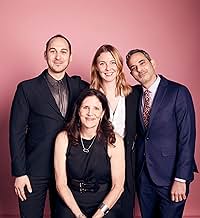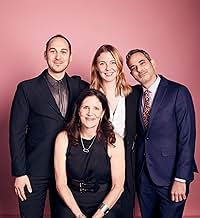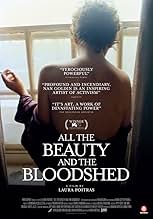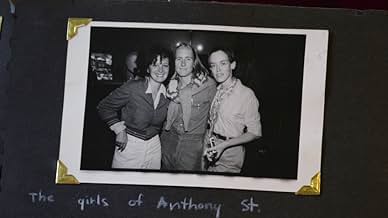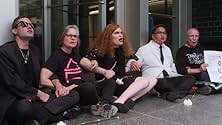IMDb रेटिंग
7.5/10
8.8 हज़ार
आपकी रेटिंग
कलाकार नान गोल्डिन के जीवन और सैकलर परिवार के पतन के बाद, फार्मास्युटिकल राजवंश जो ओपिओइड महामारी की अथाह मौत के लिए बहुत ज़िम्मेदार था.कलाकार नान गोल्डिन के जीवन और सैकलर परिवार के पतन के बाद, फार्मास्युटिकल राजवंश जो ओपिओइड महामारी की अथाह मौत के लिए बहुत ज़िम्मेदार था.कलाकार नान गोल्डिन के जीवन और सैकलर परिवार के पतन के बाद, फार्मास्युटिकल राजवंश जो ओपिओइड महामारी की अथाह मौत के लिए बहुत ज़िम्मेदार था.
- 1 ऑस्कर के लिए नामांकित
- 36 जीत और कुल 57 नामांकन
Robert Drain
- Self - Judge
- (as Judge Robert Drain)
David Armstrong
- Self - Photographer and Friend of Nan
- (आर्काइव फ़ूटेज)
Bruce Balboni
- Self - Actor
- (आर्काइव फ़ूटेज)
फ़ीचर्ड समीक्षाएं
Another important story to tell but the film itself is lacking some of that connection I'm expecting to feel.
The choice to weave Nan's personal, artistic and activism journey all together is an interesting but risky one because it weakens the delivery on either one of them.
Personally, it feels like the film is putting Nan on a pedestal, instead of where she was most of her life, the dark, dirty and forgotten edges of the city. As a result, her on screen persona sometimes feels even more out of touch than a fictional character.
For what it's worth, the film comes back to the title in the end where it ties All The Beauty And The Bloodshed that Nan has seen throughout her whole life with who she is and what she is trying to achieve now. But it's just a little bit too late for my liking.
The choice to weave Nan's personal, artistic and activism journey all together is an interesting but risky one because it weakens the delivery on either one of them.
Personally, it feels like the film is putting Nan on a pedestal, instead of where she was most of her life, the dark, dirty and forgotten edges of the city. As a result, her on screen persona sometimes feels even more out of touch than a fictional character.
For what it's worth, the film comes back to the title in the end where it ties All The Beauty And The Bloodshed that Nan has seen throughout her whole life with who she is and what she is trying to achieve now. But it's just a little bit too late for my liking.
The film attempts a profile of a photographer, but without laying groundwork to make the case for why she is, in thee filmmaker's perspective, a great artist. Viewers are shown a few slideshows of her work, images that are often uninteresting on their own -- without first being contextualized -- and then sequences of B-roll of the photographer shuffling around her studio and directing installations of her work. I got the the impression that if I were already enamored with the photographer, then I might have watched these sequences with rapt attention. Instead, knowing next to nothing about the artist, I found them boring -- and this was all within the first 15 minutes!
There are vastly more powerful films about photographers, searing works about the opioid epidemic, beautiful films about artistic process. This film intersects with each of those genres, but in an insubstantial and unmemorable way.
The buzz around this work -- and there is a lot of buzz -- seems rooted in the celebrity of the filmmaker and its subject. That's ironic, for the film appears to seek its power from themes larger than any individual, yet winds up relevant only if underpinned by the fame surrounding its maker and central character. Like the reviewer here PedroPires90 wrote ("Unfocused," March 3, 2023), "honestly it was hard to find the strength to finish it."
There are vastly more powerful films about photographers, searing works about the opioid epidemic, beautiful films about artistic process. This film intersects with each of those genres, but in an insubstantial and unmemorable way.
The buzz around this work -- and there is a lot of buzz -- seems rooted in the celebrity of the filmmaker and its subject. That's ironic, for the film appears to seek its power from themes larger than any individual, yet winds up relevant only if underpinned by the fame surrounding its maker and central character. Like the reviewer here PedroPires90 wrote ("Unfocused," March 3, 2023), "honestly it was hard to find the strength to finish it."
As "All the Beauty and the Bloodshed" (2022 release; 118 min.) opens, it is "March 10, 2018", and a group of activists is staging a protest at the Met, more particularly the Sackler Wing. We then go to "1. Merciless Logic" as Nan Goldin starts talking about her early youth, and how her sister Barbara commits suicide when Nan was only 7. At this point we are less than 10 minutes into the film.
Couple of comments: this is the latest from well respected documentarian Laura Poitras ("Citizenfour"). Here she brings us a nuanced portrait and assessment of photographer Nan Goldin, best known for documenting the NY underground scene in the 70s and 80s. At the same time Poitras looks back at the mysterious suicide of Nan's sister Barbara in 1965. And last but not least, Poitras follows Goldin and other members of the activist group P. A. I. N. in their attempts to hold the Sackler family which owns Purdue Company, manufacturer of Valium and Oxycontin, responsible for the opioid crisis in this country (Goldin herself is a survivor of Oxycontin addiction). The beauty of this documentary consisting of 7 chapters is how these three subjects are woven together, with Goldin herself narrating much of it. I was absolutely fascinated by it all, and I am already going on record that this documentary is a shoo-in to get a Best Documentary Oscar nomination.
"All the Beauty and the Bloodshed" premiered at last Fall's Venice Film Festival to immediate critical acclaim, winning the festival's top prize along the way. It is currently rated 93% Certified Fresh on Rotten Tomatoes, and for very good reasons. I see a LOT of documentaries, and surely this is one of the very best, if not THE best, documentaries of 2022, and also one of the very best movies of 2002, period. The documentary opened this weekend at my local arthouse theater here in Cincinnati. The Tuesday evening screening where I saw this at was attended very nicely (I counted about 25-30 people). If you like a top-notch documentary, I'd readily suggest you check this out, and draw your own conclusion.
Couple of comments: this is the latest from well respected documentarian Laura Poitras ("Citizenfour"). Here she brings us a nuanced portrait and assessment of photographer Nan Goldin, best known for documenting the NY underground scene in the 70s and 80s. At the same time Poitras looks back at the mysterious suicide of Nan's sister Barbara in 1965. And last but not least, Poitras follows Goldin and other members of the activist group P. A. I. N. in their attempts to hold the Sackler family which owns Purdue Company, manufacturer of Valium and Oxycontin, responsible for the opioid crisis in this country (Goldin herself is a survivor of Oxycontin addiction). The beauty of this documentary consisting of 7 chapters is how these three subjects are woven together, with Goldin herself narrating much of it. I was absolutely fascinated by it all, and I am already going on record that this documentary is a shoo-in to get a Best Documentary Oscar nomination.
"All the Beauty and the Bloodshed" premiered at last Fall's Venice Film Festival to immediate critical acclaim, winning the festival's top prize along the way. It is currently rated 93% Certified Fresh on Rotten Tomatoes, and for very good reasons. I see a LOT of documentaries, and surely this is one of the very best, if not THE best, documentaries of 2022, and also one of the very best movies of 2002, period. The documentary opened this weekend at my local arthouse theater here in Cincinnati. The Tuesday evening screening where I saw this at was attended very nicely (I counted about 25-30 people). If you like a top-notch documentary, I'd readily suggest you check this out, and draw your own conclusion.
All the Beauty and the Bloodshed can join Fire of Love in the club of Oscar-nominated documentaries from 2022 that would have been more worthy winners than Navalny. It's admittedly a small club, but I feel like both of those movies have moments that demonstrate documentary filmmaking at its best.
In the case of All the Beauty and the Bloodshed, it's probably the final 15-20 minutes that shines the brightest. It can be a slow and somewhat uneven feeling documentary at some points, but it builds to some phenomenal and emotionally hard hitting final scenes. The rest of the documentary still tends to hit far more often than it misses, but I did get the sense it may have been a tiny bit too long, and while I respect the choice not to tie together its two primary narratives more explicitly, part of me was waiting for them to collide more directly at a point. Still, leaving some of that up to the viewer felt like a deliberate choice, and I can respect that.
It follows Nan Goldin, with the film both recounting her life story from the 1950s to the 1990s and detailing her activism against the Sackler family and their role in the opioid epidemic in the 2010s. The latter might be more interesting narratively, but the former has the more interesting presentation, seeing as Goldin's an accomplished artist/photographer, and the documentary frequently relies on her work to serve as visuals.
It's a heavy and often sad documentary, dealing with mental illness, addiction, corruption, censorship, the AIDS crisis, discrimination, and domestic violence. It might be upsetting to some viewers as a result, but I think it was best not to pull punches (so long as people know what they're in for before deciding to watch it). It's a largely powerful documentary that I think will stick with me. Not perfect, but it has some amazing sequences that were very striking and moving.
In the case of All the Beauty and the Bloodshed, it's probably the final 15-20 minutes that shines the brightest. It can be a slow and somewhat uneven feeling documentary at some points, but it builds to some phenomenal and emotionally hard hitting final scenes. The rest of the documentary still tends to hit far more often than it misses, but I did get the sense it may have been a tiny bit too long, and while I respect the choice not to tie together its two primary narratives more explicitly, part of me was waiting for them to collide more directly at a point. Still, leaving some of that up to the viewer felt like a deliberate choice, and I can respect that.
It follows Nan Goldin, with the film both recounting her life story from the 1950s to the 1990s and detailing her activism against the Sackler family and their role in the opioid epidemic in the 2010s. The latter might be more interesting narratively, but the former has the more interesting presentation, seeing as Goldin's an accomplished artist/photographer, and the documentary frequently relies on her work to serve as visuals.
It's a heavy and often sad documentary, dealing with mental illness, addiction, corruption, censorship, the AIDS crisis, discrimination, and domestic violence. It might be upsetting to some viewers as a result, but I think it was best not to pull punches (so long as people know what they're in for before deciding to watch it). It's a largely powerful documentary that I think will stick with me. Not perfect, but it has some amazing sequences that were very striking and moving.
Laura Poitras' remarkable documentary ALL THE BEAUTY AND BLOODSHED which combines multiple story-lines into an incredible portrait of artist and activist, Nan Goldin. On the surface it appears as though the focus is on Goldin's attempt to bring to the public's attention the Sackler family's role as pharmaceutical kingpins during the opiod crisis. It begins with faux doctor's prescriptions and pill bottles raining down in a toney art gallery named after the Sacklers. It's a protest by Goldin's group P. A. I. N. (Prescription Addiction Intervention Now).
It's a powerful prologue, but, Poitras isn't simply interested in an advocacy documentary film here. It's a dense and intense exploration of Goldin, the person and the artist, and how her personal journey informed her activism.
Goldin is interviewed at length, and her personal writings and art are revealed in the most intimate manner. Goldin's photography evolved naturally. She was driven to document her own life and, from there, depicted an entire underground scene that had rarely been exposed to not only the art world - but, to the larger public. Goldin's fluid sexuality brought her to Provincetown and later the Burroughs of New York City, photographing everything and everyone she came in contact with. She never intentionally was putting together a portfolio - it just happened. The photographs are as private and personal as could be. Goldin never shied away from her innermost relationships, nor that of her circle of friends. That frankness is what eventually brought her to the recognition by the art world - even as it scandalized many of them. When AIDS hit her community, Goldin learned a lesson from the Act Up movement that carried on to her founding of P. A. I. N..
While all of that played out (eventually) in the public's eye, Poitras reveals Goldin's personal family life. Her strained relationship with her parents, and, most poignantly, of that with her sister who was institutionalized. Her sibling's story shows how a young woman's 'rebelliousness' can be struck down by the system and a forced dependency on drugs and a form of enslavement. It's something that Goldin carries with her to this day, including her own bout with opiods.
ALL THE BEAUTY AND THE BLOODSHED carries a lot on its plate. Poirtras' great achievement here is that no section of the movie feels out of place, nor does any part of it feel in any manner slighted. It's all of a piece melding Goldin's intensely personal quest, art and sense of social purpose.
Breathtaking.
It's a powerful prologue, but, Poitras isn't simply interested in an advocacy documentary film here. It's a dense and intense exploration of Goldin, the person and the artist, and how her personal journey informed her activism.
Goldin is interviewed at length, and her personal writings and art are revealed in the most intimate manner. Goldin's photography evolved naturally. She was driven to document her own life and, from there, depicted an entire underground scene that had rarely been exposed to not only the art world - but, to the larger public. Goldin's fluid sexuality brought her to Provincetown and later the Burroughs of New York City, photographing everything and everyone she came in contact with. She never intentionally was putting together a portfolio - it just happened. The photographs are as private and personal as could be. Goldin never shied away from her innermost relationships, nor that of her circle of friends. That frankness is what eventually brought her to the recognition by the art world - even as it scandalized many of them. When AIDS hit her community, Goldin learned a lesson from the Act Up movement that carried on to her founding of P. A. I. N..
While all of that played out (eventually) in the public's eye, Poitras reveals Goldin's personal family life. Her strained relationship with her parents, and, most poignantly, of that with her sister who was institutionalized. Her sibling's story shows how a young woman's 'rebelliousness' can be struck down by the system and a forced dependency on drugs and a form of enslavement. It's something that Goldin carries with her to this day, including her own bout with opiods.
ALL THE BEAUTY AND THE BLOODSHED carries a lot on its plate. Poirtras' great achievement here is that no section of the movie feels out of place, nor does any part of it feel in any manner slighted. It's all of a piece melding Goldin's intensely personal quest, art and sense of social purpose.
Breathtaking.
क्या आपको पता है
- ट्रिवियाThe title of the film is a reference to Nan Goldin's older sister, Barbara Holly Goldin. It's a direct quote from a mental health evaluation of Barbara during her time at an institution. She died by suicide in 1965, at the age of 18. This film and Nan Goldin's 1986 "The Ballad of Sexual Dependency" are dedicated to her.
- भाव
Self - Nan's Mother: Droll thing life is -- that mysterious arrangement of merciless logic for a futile purpose. The most you can hope from it is some knowledge of yourself -- that comes too late -- a crop of inextinguishable regrets. Joseph Conrad, Heart of Darkness
- साउंडट्रैकThe Cold Song
Performed by Klaus Nomi
टॉप पसंद
रेटिंग देने के लिए साइन-इन करें और वैयक्तिकृत सुझावों के लिए वॉचलिस्ट करें
- How long is All the Beauty and the Bloodshed?Alexa द्वारा संचालित
विवरण
- रिलीज़ की तारीख़
- कंट्री ऑफ़ ओरिजिन
- आधिकारिक साइटें
- भाषा
- इस रूप में भी जाना जाता है
- Hayatın Tüm Acıları ve Güzellikleri
- फ़िल्माने की जगहें
- न्यूयॉर्क शहर, न्यूयॉर्क, संयुक्त राज्य अमेरिका(Metropolitan Art Museum protest)
- उत्पादन कंपनियां
- IMDbPro पर और कंपनी क्रेडिट देखें
बॉक्स ऑफ़िस
- US और कनाडा में सकल
- $5,00,082
- US और कनाडा में पहले सप्ताह में कुल कमाई
- $28,803
- 27 नव॰ 2022
- दुनिया भर में सकल
- $14,83,975
- चलने की अवधि1 घंटा 53 मिनट
- रंग
- ध्वनि मिश्रण
- पक्ष अनुपात
- 1.78 : 1
इस पेज में योगदान दें
किसी बदलाव का सुझाव दें या अनुपलब्ध कॉन्टेंट जोड़ें





